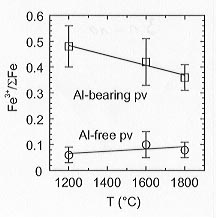

Previous in-situ electrical conductivity measurements of silicate perovskite suggest that activation energies are larger at high temperature (0.6-0.9 eV) than at low temperature (0.2-0.5 eV). This apparent change in activation energy with temperature suggests that either (1) either the number of charge carriers changes as a function of temperature, or (2) there is a change in the dominant mechanism of electrical conductivity. In either case there are important implications for the electrical conductivity of the lower mantle, since laboratory measurements must be extrapolated to higher temperatures. In order to explore this question further, we determined the temperature dependence of electrical conductivity in silicate perovskite using complex impedance spectroscopy at high-pressures in the multianvil press, and used Mössbauer spectroscopy to determine the concentration of Fe3+ corresponding to the conductivity measurements.
The electrical conductivity of Al-bearing perovskite measured at 25 GPa and 100-1700°C is shown in Figure 3.1-9. The results are reproducible and reversible as shown by the consistent values obtained during heating and cooling cycles. In agreement with previous results, the data show steeper slopes at higher temperatures, and were accordingly fit to three linear equations representing three different temperature regions. Figure 3.1-10 shows the temperature dependence of the proportion of Fe3+ in perovskite. The results show that the proportion of Fe3+ in Al-free perovskite is low but increases with temperature, while it decreases with temperature in Al-bearing perovskite. Calculations are underway to estimate the number of charge carriers using the Mössbauer data, and hence determine whether a change in the mechanism of electrical conductivity with temperature in silicate perovskite is consistent with the data. Mobility of the charge carriers can also be computed from the measured conductivity and the number of charge carriers.
 |
 |
Fig. 3.1-9: Electrical conductivity of Al-bearing perovskite as a function of reciprocal temperature. Diamonds are for decreasing temperature and circles are for increasing temperature. |
Fig. 3.1-10: The relative proportion of Fe3+ in perovskite vs. temperature. |

Tel: +49-(0) 921 55 3700 / 3766, Fax: +49-(0) 921 55 3769, E-mail: bayerisches.geoinstitut(at)uni-bayreuth.de
 Previous page
Previous page